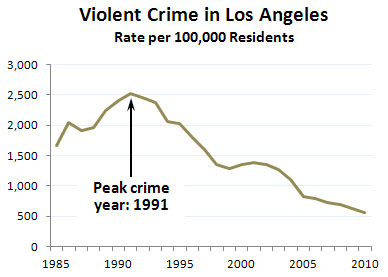With the first quarter of 2013 in the books, crime in Los Angeles has so far continued its decade-long decline, according to statistics released Friday.
OK, first off: can we please stop talking about LA’s “decade-long” crime drop? I know I’ve mentioned this often enough that I sound like a crank on the subject, but it’s important. If crime started declining in 2003, it might well be due to improved policing techniques introduced by Bill Bratton in 2002. But if it started declining in 1991—which it did—then the cause has to be something else, unless Bratton invented not just CompStat, but time travel as well. Moving on:
Mayor Antonio Villaraigosa and Police Chief Charlie Beck announced the early but notable improvement at a press conference that served as a swan song for the mayor, who will leave office this summer after being termed out….Beck highlighted the significant declines in gang-related killings and other crimes — a result, he said, of close cooperation between his department and the city’s aggressive anti-gang programs that.
….”There is no other big city in America that can make these claims. I invite any of you to go to Chicago, go to New York, go to Houston … and see if you can find a replication of this effort. You cannot,” Beck said.
Look: the crime decline in Los Angeles has been impressive. More cops on the street have probably been effective. Beck’s gang initiatives have probably been effective—maybe even more effective than in other places. But no other city can make these claims? It’s exactly the opposite: nearly every big city can make these claims. The violent crime rate in Phoenix is down 52 percent from its peak. Washington DC is down 58 percent. Chicago is down 66 percent. Dallas is down 70 percent. New York is down 75 percent.
In California, San Jose is down 58 percent. San Francisco is down 61 percent. San Diego is down 67 percent.
We should all applaud anti-crime initiatives that seem to be effective. But we should also rigorously question whether they’re effective. And we shouldn’t mindlessly repeat claims that just flatly aren’t true, no matter who or where they come from. The public deserves to hear the full story about crime in America, not just the part that’s convenient for politicians singing their swan songs or police chiefs who want funding for more cops.
















